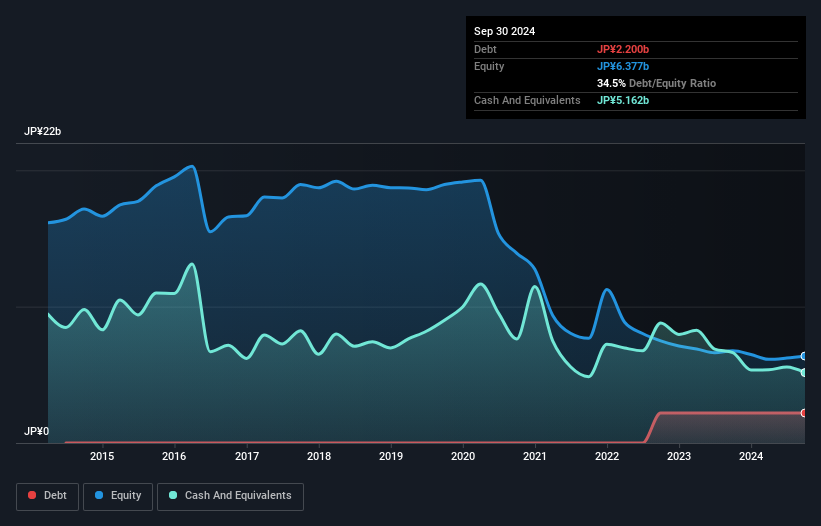
The external fund manager backed by Berkshire Hathaway's Charlie Munger, Li Lu, makes no bones about it when he says 'The biggest investment risk is not the volatility of prices, but whether you will suffer a permanent loss of capital.' So it might be obvious that you need to consider debt, when you think about how risky any given stock is, because too much debt can sink a company. We can see that Gurunavi, Inc. (TSE:2440) does use debt in its business. But the real question is whether this debt is making the company risky.
Why Does Debt Bring Risk?
Debt assists a business until the business has trouble paying it off, either with new capital or with free cash flow. If things get really bad, the lenders can take control of the business. However, a more common (but still painful) scenario is that it has to raise new equity capital at a low price, thus permanently diluting shareholders. By replacing dilution, though, debt can be an extremely good tool for businesses that need capital to invest in growth at high rates of return. When we examine debt levels, we first consider both cash and debt levels, together.
Check out our latest analysis for Gurunavi
What Is Gurunavi's Net Debt?
As you can see below, Gurunavi had JP¥2.20b of debt, at September 2024, which is about the same as the year before. You can click the chart for greater detail. But on the other hand it also has JP¥5.16b in cash, leading to a JP¥2.96b net cash position.

How Strong Is Gurunavi's Balance Sheet?
The latest balance sheet data shows that Gurunavi had liabilities of JP¥2.10b due within a year, and liabilities of JP¥2.55b falling due after that. Offsetting this, it had JP¥5.16b in cash and JP¥2.66b in receivables that were due within 12 months. So it actually has JP¥3.17b more liquid assets than total liabilities.
This surplus suggests that Gurunavi is using debt in a way that is appears to be both safe and conservative. Given it has easily adequate short term liquidity, we don't think it will have any issues with its lenders. Succinctly put, Gurunavi boasts net cash, so it's fair to say it does not have a heavy debt load!
We also note that Gurunavi improved its EBIT from a last year's loss to a positive JP¥12m. The balance sheet is clearly the area to focus on when you are analysing debt. But you can't view debt in total isolation; since Gurunavi will need earnings to service that debt. So when considering debt, it's definitely worth looking at the earnings trend. Click here for an interactive snapshot.
Finally, a company can only pay off debt with cold hard cash, not accounting profits. While Gurunavi has net cash on its balance sheet, it's still worth taking a look at its ability to convert earnings before interest and tax (EBIT) to free cash flow, to help us understand how quickly it is building (or eroding) that cash balance. Over the last year, Gurunavi saw substantial negative free cash flow, in total. While that may be a result of expenditure for growth, it does make the debt far more risky.
Summing Up
While it is always sensible to investigate a company's debt, in this case Gurunavi has JP¥2.96b in net cash and a decent-looking balance sheet. So we are not troubled with Gurunavi's debt use. Even though Gurunavi lost money on the bottom line, its positive EBIT suggests the business itself has potential. So you might want to check out how earnings have been trending over the last few years.
If, after all that, you're more interested in a fast growing company with a rock-solid balance sheet, then check out our list of net cash growth stocks without delay.
New: Manage All Your Stock Portfolios in One Place
We've created the ultimate portfolio companion for stock investors, and it's free.
• Connect an unlimited number of Portfolios and see your total in one currency
• Be alerted to new Warning Signs or Risks via email or mobile
• Track the Fair Value of your stocks
Have feedback on this article? Concerned about the content? Get in touch with us directly. Alternatively, email editorial-team (at) simplywallst.com.
This article by Simply Wall St is general in nature. We provide commentary based on historical data and analyst forecasts only using an unbiased methodology and our articles are not intended to be financial advice. It does not constitute a recommendation to buy or sell any stock, and does not take account of your objectives, or your financial situation. We aim to bring you long-term focused analysis driven by fundamental data. Note that our analysis may not factor in the latest price-sensitive company announcements or qualitative material. Simply Wall St has no position in any stocks mentioned.
About TSE:2440
Gurunavi
Offers web-based information services related to restaurants through PC and smartphones in Japan.
Excellent balance sheet with acceptable track record.
Market Insights
Community Narratives


